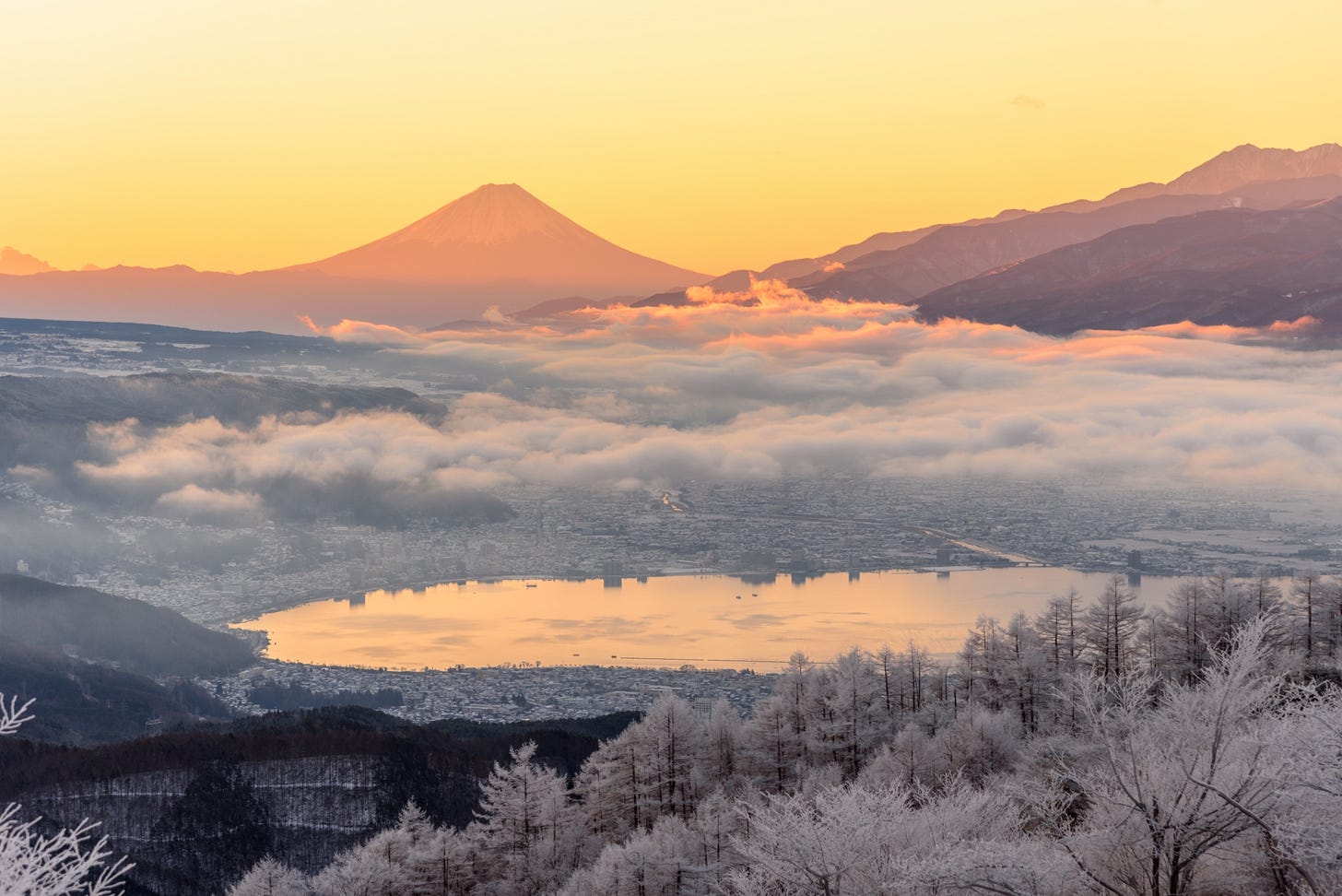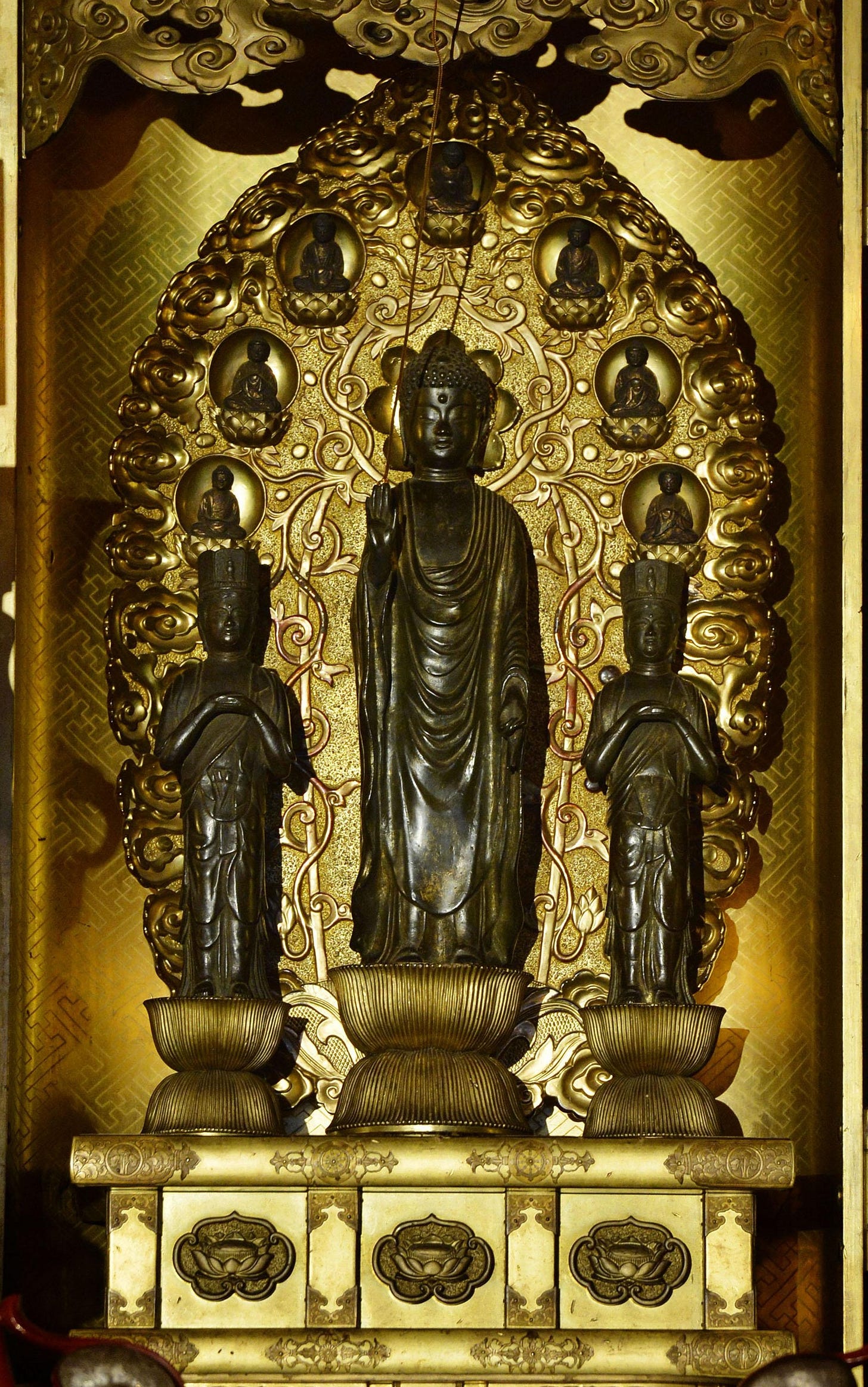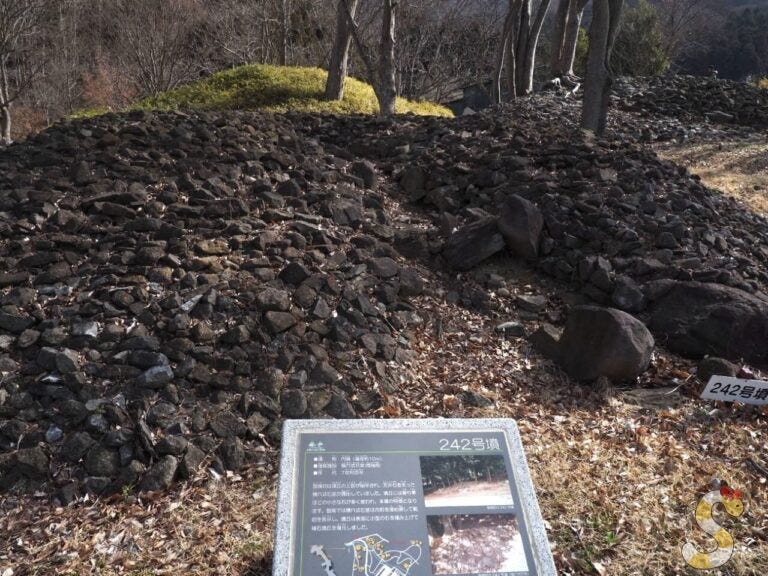Searching for the Sinjoh Ruins in Real-World Japan
Is Zenkōji the inspiration for the Sinjoh Ruins?
The Sinjoh Ruins are a key point of connection across the Pokemon universe. They introduce a web of relationships between four creator deities. And in a unique cutscene, they even show in astonishing and surreal imagery the power of the main creator deity, Arceus, to create life and shape the world. The Ruins are also an important link between regions—Sinnoh and Johto—which gives the ruins its name. As legend has it, the once-temple was built collaboratively by the people of the two regions, the Johto people and the ancient Celesticans of Sinnoh. This teases a plausible “deep history” to the Pokemon world, suggesting an ancient cultural connection behind the presence of Unown script and complex ruins in each region. The Sinjoh ruins, introduced in 2009 as Generation Four remakes of Generation Two games, build on key concepts of their ancestor. If Gen 2 Johto was the first region to build hundreds or more years of history into the Pokemon world, Gen 4 Johto made it official by expanding that cultural network across regions and time.
Fascinating, but an enigma. The Sinjoh Ruins offers very little physical context to clue the player into any real-world inspiration. Based on the poems in Pokemon Legends: Arceus, the temple is not in modern-day Sinnoh. The fourth Old Verse clearly describes Hisui and Sinnoh as two distinct places that are similar in climate:
“Wintry... Austere... Brimming with strange power... Certainly the land of Hisui bears some resemblance to Sinjoh. Here, where the ancient Sinnoh people were born, I will spend an eternity... until the one with the mission appears.”
The Sinjoh Ruins also appear in the Gen 4 Johto games—but they’re not quite in the region either! Is this purely an invention of Game Freak? Is there any place in the world whose history resembles the Sinjoh Ruins?
As it turns out, there is—and whether it is the inspiration or not, the case of Zenkōji offers a phenomenal means of understanding Japanese history, and its connections across East Asia, through the example of Pokemon lore. Zenkōji Temple is nestled deep within the cold valleys of the mountainous Nagano region, which very likely has an in-game counterpart where the Sinjoh Ruins are located.
Why Nagano? The limited evidence given in the Generation Four games points to Nagano as the location of the ruins—but like many things in Pokemon, it is filtered through several layers of creative adaptation.
Just as the Kanto region recalls the Tokyo area (named Kanto in real life), Hoenn resembles Kyushuu, and Sinnoh’s map is a direct match with Hokkaido, Johto is based directly on the Kyoto-Osaka region (Kansai). Ecruteak City is a very close match for Kyoto, Olivine city and its harbor and Glitter Lighthouse resemble the key harbor city of Kobe, while the gigantic and bustling Goldenrod City is a clear counterpart to the old merchant city of Osaka. Even the Lake of Rage appears to be the counterpart to Lake Biwa, which sits slightly to the northeast of Kyoto. This would be a very appropriate place to find ancient ruins, as this region supported the Japanese imperial family deep in the historical past and is the site of many actual temples and ruins. But the limited information we have about the Sinjoh Ruins poses a problem to this interpretation:
They are outside of the Johto area! They appear, but to the north of the map. Fortunately, we can take a guess at their location by resolving a different inconsistency in the Pokemon town map: the location of Mt. Silver relative to Johto. Mt. Silver is based on Mt. Fuji, the tallest mountain in Honshu and right to the West of Tokyo. But this, too, is strange: Kyoto is not near Mt. Fuji. Have a look at the map below.
Another whole city, Nagoya, sits between them. But what happens if we mentally fold the map of Japan back along Nagoya, so as to line Kyoto up with Mt. Fuji, just like it appears on the Town Map?
Suddenly the map of Japan bears a close resemblance to the Town Map in Johto. But in this case, what about that mysterious arrow pointing North? What does it indicate now?
Now it points directly to Nagano, a beautiful, cold, and snowy region. Just like the tiny bit of the landscape we see in HGSS, it is filled with mountains and canyons that visually resemble the surroundings of the Sinjoh ruins. But what on earth is there that might be a counterpart to the Sinjoh Ruins? Why should we expect to find something ancient and of deep historical significance in such a remote and difficult-to-access region?
[Nagano is also cold and austere, especially in winter. From Japan Wonder Travel Blog]
This is where things get really interesting. Nagano is home to Zenkōji Temple, an ancient temple that is likely one of the oldest in Japan. Zenkōji is said to have been founded in 644 AD, about a hundred years after Buddhism was first brought to Japan. This is one of the first Buddhist temples to be built, and it’s incredible that it still stands today. Its contemporaries are places like Horyu-ji in Nara, one of the oldest wooden structures in the world. In fact, most of the construction of Buddhist temples was initially near the Japanese imperial court in Nara. The court hoped to secure blessings and benefits for the realm, while Buddhist clergy hoped to exert their influence on the Japanese rulers. But Zenkōji was somehow built very far away from all of that action!
(From Myoko Tourism, https://myokotourism.com/wp-content/uploads/2019/06/zenkoji-temple.jpg)
So what is so important about Zenko-ji? The temple is bound up in Japan’s relationships with other East Asian countries, and the establishment of Buddhism in Japan. The nation that introduced Japan to Buddhism was the powerful Paekche kingdom, an ancient progenitor of modern-day Korea. In the mid 500s, a diplomatic Paekche mission brought Buddhist statues, paintings, and sutras to Japan, whose rulers diligently installed them in a small temple. The gods of Japan rejected the foreign influence, and unleashed a deadly epidemic. The temple was burned and the statues, a buddha and two flanking bodhisattvas, were separated and thrown into a river. After another diplomatic Korean mission, the Japanese gods and their people gradually began to accept and practice Buddhism. But what about the statues that were thrown into the river? They appeared in a dream to Honda Yoshimitsu (whose name is also pronounced Zenko), who fished them out and established a temple focused on their worship. Eventually, this community of worshippers became Zenko-ji.
Here we already have some interesting parallels with the Sinjoh Ruins. The appearance of Buddhist statues in groups of three is extremely common in temples, as each represents different aspects of Buddhism’s transcendent deity and universal truths. This resembles the three symbols on the Mystri Stage, which represent gods who in turn seem to be subordinate to Arceus’ power. The original trio of sculptures is always hidden at Zenkōji, with a copy revealed to visitors every seven years. This in turn recalls Arceus’ concealed presence at the Sinjoh Ruins, while the symbols of Palkia, Dialga, and Giratina are instead presented to visitors. Further, Zenkōji Temple is bound up in the history of Japan’s contact with powerful worshippers of other gods, a concept that recalls the collaborative construction of the temple at Sinjoh. But the people of Paekche didn’t help build Zenkōji… did they?
Zenko-ji is indeed in a difficult-to-access, remote location—in relation to Kyoto or Tokyo. It’s much easier to reach by sea. And accordingly, the coastline of Nagano has an extensive history, with ruins whose age stretches back into the Neolithic period. Its archaeological sites are bursting with new discoveries about Japanese history. And some of that history challenges the idea of its cultural or even international isolation. Up and down the Western coast of Japan, there have been consistent finds of cut-stone burial mounds. These are scattered along the coast, and Japan did not practice this type of burial at the time—but the Paekche Kingdom did. This Korean power had an extensive naval fleet, and in addition to sending ships along the coast loaded with diplomats, they also partially settled the Western coast of Japan. And that coast is much closer to Nagano than it is to Nara or Tokyo.
There is abundant evidence of a Korean (Paekche) community living in Nagano at the time Zenkōji was built. The temple is even also alternately referred to as Paekche-Zenkōji. The term “Paekche Temple” was used throughout Japan for many temples in reference to the Korean communities that lived nearby at the time of their construction. And, most tellingly, there are also cut stone burials all throughout the area, clearly indicating that people from Paekche migrated into the mountain valleys of Nagano. (Historians argue that they settled the Nagano Plain to raise horses, as appropriate land was scarce in the Korean Peninsula.)
[Picture and discussion of Paekche Burial sites from https://skima-shinshu.com/wp-content/uploads/2022/04/P3160072-1-768x576.jpg]
The architectural design of Buddhist temples did not originate in Japan, nor did Buddhism itself; they were both introduced through the missions and careful, determined instruction of the Paekche Kingdom. As several historical texts convey, Zenkōji was likely collaboratively built by Korean Buddhists and recently converted Japanese practitioners. This contact is even the origin story for the temple, as it deliberately recalls the foreign contact that introduced Buddhism to Japan, transforming it from a story of fear to once of Buddhist resilience.
Zenkōji Temple is a historical symbol of the collaborative early worship of Buddhism by international Korean missionaries and Japanese practitioners. Nestled in the cold, snowy mountains of Nagano, it’s a close match and possible inspiration for the key themes of the Sinjoh ruins, and the collaborative efforts of the Celesticans and Johto people to establish an international temple for the worship of Arceus.
Subscribe for free to get first dibs on my next post!
https://bulbapedia.bulbagarden.net/wiki/File:Johto_Sinjoh_Ruins_Map.png
https://bulbapedia.bulbagarden.net/wiki/File:Sinjoh_Ruins_HGSS.png
https://www.kcpinternational.com/2015/05/zenko-ji-gokaicho-a-once-every-7-years-event/
http://www.art-and-archaeology.com/japan/zenkoji5.html
https://bulbapedia.bulbagarden.net/wiki/File:Sinjoh_Ruins_Mystri_Stage_Active_HGSS.png
https://skima-shinshu.com/wp-content/uploads/2022/04/P3160072-1-768x576.jpg













